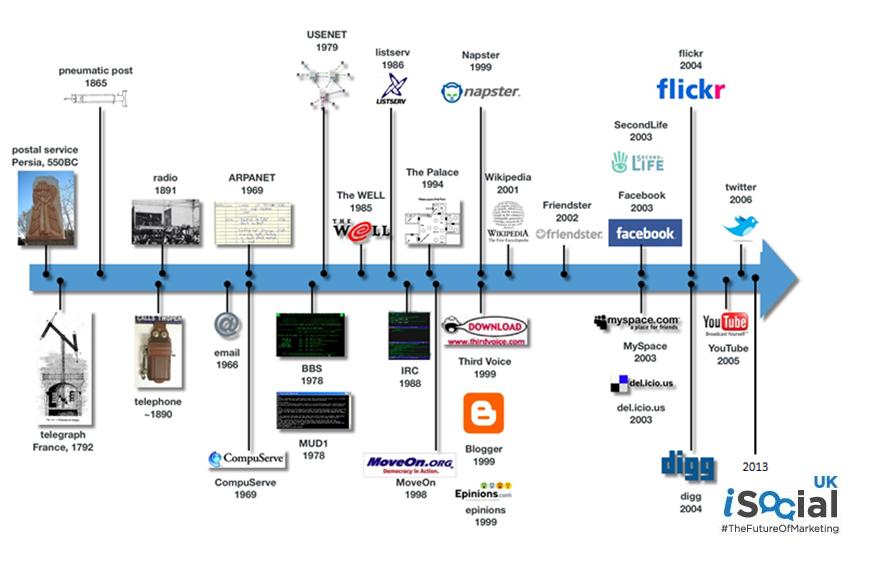The History of Social Media (Part 1)
In 1971 the first email was sent, which indicated the start of the digital communication revolution. The next historic moment was the introduction of the World Wide Web in 1989 by British engineer Tim Berners-Lee which consequently paved the way for the start of social networking sites, the first of which was named ‘SixDegrees’ in 1997. SixDegrees.com allowed users to create profiles, list their friends and message them. Although SixDegrees attracted millions of users, it failed to become a sustainable business and the service closed in 2000. It was argued that an extended network of friends was not yet available online and SixDegrees was in fact ahead of its time. The internet proved to be a quick and vast phenomenon; however users still lacked an extended network of friends online, which left them with little to do, with most users apathetic to engage with strangers.
The next wave of Social media platforms began when Ryze.com was launched in 2001 to help people leverage their business networks. The entrepreneurs behind Ryze, Tribe.net, LinkedIn and Friendster were close on a personal and professional level; they believed that they could support each other without directly competing. Despite their best efforts, Ryze didn’t reach the user popularity as first anticipated. Tribe.net positioned itself in the market with a very niche user base which drifted away from the generic social media user platform. LinkedIn became the most established, quickly foreseeing a gap in the market for a powerful online business service, allowing professionals to network on a global scale. LinkedIn was the only social media platform with a successful business plan, allowing users to commit to a monthly package which would see their basic options expanded, allowing greater opportunities to engage with professionals. Friendster consequently became the most mainstream out of the initial social media revolution stage, which has been described in recent times as ‘‘one of the biggest disappointments in Internet history,’’.
Friendster launched in 2002 to complement Ryze. It was designed to compete with Match.com, a profitable online dating site and grew to 300,000 users through word of mouth before traditional press coverage began in May 2003. As Friendster’s popularity rapidly increased, the site encountered unforeseen technical and social difficulties. Friendster’s servers and databases were unprepared to handle its rapid growth, which lead to its decline. As users were left frustrated and discouraged with the service, along with a contribution of negative user experiences, it eventually led to the eventual downfall of Friendster. As a result of their initial design which restricted users to view profiles of people who were more than four degrees away (friends-of-friends-of-friends-of-friends), users began creating fake profiles, known as ‘Fakesters’. These ‘‘Fakesters’’ outraged the company, who in turn banned the use of fake profiles, signalling to stakeholders that the company did not share the same user interests.
In 2003, neither competitors nor journalists anticipated the launch of MySpace in Santa Monica, California, hundreds of miles from Silicon Valley, to compete with leading sites like Friendster, according to co-founder Tom Anderson. MySpace differentiated itself by regularly adding features based on user demand and by allowing users to personalize their page, a feature which was new to the world of social media and something Friendster had failed to adopt. This had attracted teenagers in the mass numbers in 2004. Unlike older users, most teens were never on Friendster. This was due to the fact that most of them wanted to follow their favourite bands, which encouraged their peers to join the social networking site. Rumours had erupted that Friendster would expose their members to adopt a fee based service. This backfired and encouraged Friendster users to join competitor social media platforms Tribe.net and MySpace.
As a result of this, MySpace was able to grow rapidly by capitalizing on Friendster’s alienation of its early adopters. Interestingly, indie rock bands that were expelled from Friendster for failing to obey profile regulations, encouraged users to switch to MySpace, which was noticeable in MySpace’s later life cycle, adopting a strong emphasise over music dominated users. While this wasn’t part of MySpace’s business plan, musicians were welcomed to the social networking site. Promoters started to use MySpace to promote for nightclubs which intrigued MySpace as to how they could best support local music scenes. This was the first public example of businesses employing social media tactics. Although musicians and bands were not the only source of growth MySpace experienced, but their relationship mutually benefitted beyond the experience between Friendster and their former users.
Due to the lack of mainstream press coverage in 2004, MySpace’s growing popularity went unnoticed until they were purchased for $580 million by News Corporation in July 2005, attracting mass media attention which led to a series of safety issues which plagued MySpace. MySpace experienced a series of sexual interactions between adults and minors, prompting legal action. A moral panic concerning sexual predators quickly spread, making the reality conscious for online users.
As a result of MySpace’s initial success, websites that focused on media sharing recognised the potential of social media and began implementing social media orientated websites themselves. Examples include Flickr (photo sharing), Last.FM (music listening) & YouTube (video sharing) which all launched in late 2004/early 2005 with YouTube being purchased by Google for $1.65 billion in the fourth quarter of 2006 and Flickr being purchased for $35million the year before.
Stay tuned for The History of Social Media Part 2 – Life After Facebook.
#TheFutureOfMarketing
By Chris Kyriacou

